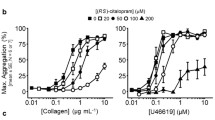Abstract
Serotonin (5-hydroxytryptamine; 5-HT) has important peripheral functions that include roles in platelet function, primarily in aggregation and modulation of vascular tone. Platelet serotonin is derived predominantly via uptake from the enterochromaffin system. Selective serotonin reuptake inhibitors (SSRIs) substantially reduce platelet serotonin stores via uptake inhibition. SSRIs are associated with infrequent clinical reports of haemostatic dysfunction, primarily easy bruising.
These clinical reports have not, however, been paralleled by prospective studies, which have not found any disturbances in haemostatic function secondary to SSRI therapy. SSRI-associated haemostatic dysfunction appears to be a rare adverse event, and has not been reported to be associated with mortality or substantial morbidity. Nevertheless, a high index of suspicion is warranted in any patient on SSRI therapy who develops unexplained changes in haemostatic function.
Similar content being viewed by others
References
Prichard BN, Smith CC. Serotonin: receptors and antagonists — summary of a symposium. Clin Physiol Biochem 1990; 8(3 Suppl.): 120–8
Leonard BE. Blood cells as models of neurons: studies in the affective disorders. J Ir Coll Phys Surg 1991; 20: 282–4
Pearse AGE. The diffuse neuroendocrine system: peptides, amines, placodes and the APUD theory. Prog Brain Res 1986; 68: 25–31
Stahl SM. The human platelet. A diagnostic and research tool for the study of biogenic amines in psychiatric and neurologic disorders. Arch Gen Psychiatry 1997; 34: 509–16
Tuomisto J, Tukiainen E. Decreased uptake of 5-hydroxytryptamine in blood platelets from depressed patients. Nature 1976; 262: 596–8
Arora RC, Meltzer HY. Increased serotonin 2 receptor binding as measured by 3H-LSD binding in the blood platelets of depressed patients. Life Sci 1989; 44: 725–34
Berk M, Bodemer W, Van Oudenhove T, et al. The platelet intracellular response to serotonin is augmented in bipolar manic and depressed patients. Hum Psychopharmacol 1995; 10: 189–93
Mikuni M, Kagaya A, Takahashi K, et al. Serotonin but not norepinephrine-induced calcium mobilisation of platelets is enhanced in affective disorders. Psychopharmacology 1992; 106: 311–4
Mikuni M, Kusumi I, Kayaga A, et al. Increased 5-HT2 receptor function as measured by serotonin-stimulated phosphoinositide hydrolysis in platelets of depressed patients. Prog Neuropsychopharmacol Biol Psychiatry 1991; 15: 49–61
Read NW, Gwee KA. The importance of 5-hydroxytryptamine in the gut. Pharmacol Ther 1994; 62: 159–73
Verbeuren TJ, Synthesis, storage and release of 5-hydroxytryptamine in peripheral tissues. In: Fozard JR, editor. The peripheral actions of 5-hydroxytryptamine. New York: Oxford University Press, 1989: 1–25
Blockmans D, Deckmyn H, Vermylen J. Platelet activation. Blood Rev 1993; 9: 143–56
Salzman AG, Morose B, Whitman MM, et al. Cloning of the human serotonin 5-HT2 an 5-HT1C receptor subtypes. Biochem Biophys Res Commun 1991; 181: 1469–78
Skop BP, Brown TM. Potential vascular and bleeding complications of treatment with selective serotonin reuptake inhibitors. Psychosomatics 1996; 37: 12–6
Houston DS, Shepherd JT, Vanhoutte PM. Aggregating human platelets causes direct contraction and endothelium-dependant relaxation of isolated canine coronary arteries: role of serotonin, thromboxane A2 and adenine nucleotide. J Clin Invest 1986; 78: 539–44
George JN, Shattil SJ. The clinical importance of acquired abnormalities in platelet function. N Engl J Med 1991; 324: 27–39
Jain MK, Eskow K, Kunchibhotla J, et al. Correlation of inhibition of platelet aggregation by phenothiazines and local anaesthetics with their effects on a phospholipid bilayer. Thromb Res 1978; 13: 1067–75
Celada P, Dolera M, Alvarez E, et al. Effects of acute and chronic treatment with fluvoxamine on extracellular and platelet serotonin in the blood of major depressive patients. Relationship to clinical improvement. J Affect Disord 1992; 25: 243–9
Wernicke JF. The side effect profile and safety of fluoxetine. J Clin Psychiatry 1985; 46: 59–67
Lemberger L, Bergstrom RF, Wolen RL, et al. Fluoxetine: clinical pharmacology and physiologic disposition. J Clin Psychiatry 1985; 46: 14–9
Alderman CP, Moritz CK, Ben-Tovim DI. Abnormal platelet aggregation associated with fluoxetine therapy. Ann Pharmacother 1992; 26: 1517–9
Yaryura-Tobias JA, Kirschen H, Ninan P, et al. Fluoxetine and bleeding in obsessive compulsive disorder [letter]. Am J Psychiatry 1991; 148: 949
Humphries JE, Wheby MS, VandenBerg SR. Fluoxetine and the bleeding time. Arch Pathol Lab Med 1990; 114: 727–8
Evans TG, Buys SS, Rodgers GM. Acquired abnormalities of platelet function [letter]. N Engl J Med 1991; 324: 1671
Stanford MS, Patton JH. In utero exposure to fluoxetine HCl increases hematoma frequency at birth. Pharmacol Biochem Behav 1993; 45: 959–62
Data on File, Eli Lilly & Co.
Kotsanos JG, Sayler ME, Masica DN, et al. Utilisation of a computerised clinical trial database in epidemiological studies: comparison of bruising events in fluoxetine clinical trials [abstract]. Clin Res 1992; 39: 768a
Aranth J, Lindeburg C. Bleeding, a side effect of fluoxetine [letter]. Am J Psychiatry 1992; 149: 412
Pai VB, Kelly MW. Bruising associated with the use of fluoxetine. Ann Pharmacother 1996; 30: 786–8
Gunzberger DW, Martinez D. Adverse vascular effects associated with fluoxetine [letter]. Am J Psychiatry 1992; 149:1751
Bang NU. Acquired abnormalities of platelet fuction [letter]. N Engl J Med 1991; 324: 1672
Alderman CP, Seshadri P, Ben-Tovim DI. Effects of serotonin reuptake inhibitors on haemostasis. Ann Pharmacother 1996; 30: 1232–4
Berk M, Jacobson BF, Hurly E. Fluoxetine and hemostatic function: a pilot study. J Clin Psychiatry 1995; 56: 14–6
Leung M, Shore R. Fluvoxamine-associated bleeding [letter]. Can J Psychiatry 1996; 41: 604–5
Ottervanger JP, Stricker BHCH, Huls J, et al. Bleeding attributed to the intake of paroxetine. Am J Psychiatry 1994; 151: 781–2
Bannister SJ, Hauser VP, Hulse JD. Evaluation of the potential for interactions of paroxetine with diazepam, cimetidine, warfarin and digoxin. Acta Psychiatr Scand 1989; 80(350 Suppl.): 102–6
Calhoun JW, Calhoun DD. Prolonged bleeding time in a patient treated with sertraline [letter]. Am J Psychiatry 1996; 153:443
Krivy J, Wiener J. Sertraline and platelet counts in idiopathic thrombocytopenia purpura [letter]. Lancet 1995; 345: 132
Data on File, Eli Lilly & Co.
Author information
Authors and Affiliations
Corresponding author
Rights and permissions
About this article
Cite this article
Berk, M., Jacobson, B.F. Selective Serotonin Reuptake Inhibitor-Induced Disturbances of Haemostasis. CNS Drugs 10, 441–446 (1998). https://doi.org/10.2165/00023210-199810060-00005
Published:
Issue Date:
DOI: https://doi.org/10.2165/00023210-199810060-00005




